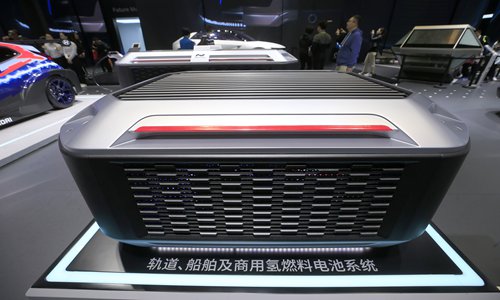China accelerating hydrogen construction, but still lacks top-level design
By Wang Sheng Source:Global Times Published: 2020/6/11 23:12:28

A view of hydrogen fuel cell at Hyundai’s exhibition area during the 2nd CIIE Photo: Yang Hui/GT
China has deployed the hydrogen industry in many provincial-level regions, but insiders think China is still lacking in top-level design, and needs to produce hydrogen in an environmentally and economically sound way.Beijing Municipal government announced Wednesday that it will further develop hydrogen cell fuel vehicles (HCFVs) and build itself into a leading pilot city nationwide to promote the hydrogen industry from 2020 to 2022.
Jiaxing, East China's Zhejiang Province, announced Tuesday it will invest $1 billion to develop an entire chain of the hydrogen industry. By 2025, the city will build more than 20 stationary hydrogen stations and operate 1,500 HCFVs with an annual output value of 30 billion yuan.
Many regions nationwide including Jinan, Zhangjiakou and Foshan are accelerating deployment of the hydrogen industry by building HCFVs, filling stations and pipelines.
Auto and energy firms including the three biggest domestic oil companies are actively developing the hydrogen industry in order to reduce dependence on imports of oil and gas as well as exploring energy transition.
Industry insiders think hydrogen, as a clean source of energy, will help China reduce emissions of air pollutants, and that it could boost development of the green economy.
20 years ago, China approved the West-East Gas Pipeline Project, turning resource advantages in western areas into an economic advantage and transporting clean energy to eastern and central regions which are short of energy. 20 years later, experts expect that pushing the hydrogen industry can also alleviate the imbalance of energy distribution in China.
Zou Caineng, an academician from the Chinese Academy of Sciences (CAS), explained in a book that hydrogen is obtained through the conversion of primary energy such as solar, wind and thermal energy, and can generate electricity through fuel cell technology. Electricity can also be used to make hydrogen from water and therefore connecting and transferring energy through the entire energy network can be realized.
During the two sessions this year, experts discussed sources of hydrogen production. China should gradually promote the transition from grey hydrogen to blue hydrogen and green hydrogen, said Lü Lianggong, a representative of Zhenhai Refining & Chemical Company, a subsidiary of China Petrochemical Corp, according to domestic media reports.
CAS academicians Bao Xinhe and Li Can both stated that from the perspective of carbon emissions, China should develop green hydrogen, which is produced from renewable energy sources, according to China Energy News.
Li said that hydrogen, in the emerging period, can be produced by a few projects from coal, but China shouldn't put too many coal-to-hydrogen projects into production due to the need to reduce carbon emissions and pollutants.
However, green hydrogen production is very expensive currently. The Global Times found that the price of green hydrogen is about 38 yuan ($5.38) per kilogram, about three to four times the price of hydrogen from fossil fuel energy sources.
Insiders told the Global Times China can expand the application scale of green hydrogen, thereby cutting production costs.
Some experts told the Global Times that China also can produce blue hydrogen by utilizing CCUS (carbon capture, utilization and storage) technologies, thereby reducing carbon emissions from fossil fuel energy sources. But the technology still needs commercial operation projects in China, which will have to be spurred by policies given the high cost of investment.
Furthermore, insiders suggested that China still needs to improve the top-level design of the hydrogen industry, make efforts to achieve production localization of core parts, and establish technical standards for the industry as soon as possible.